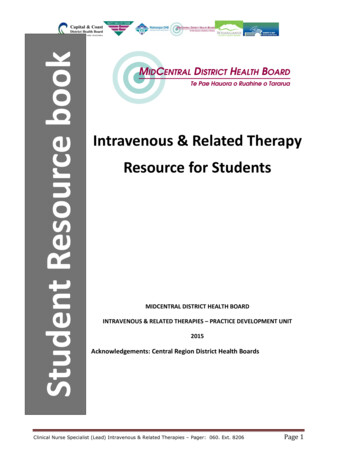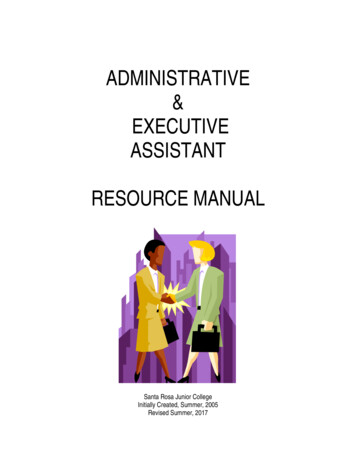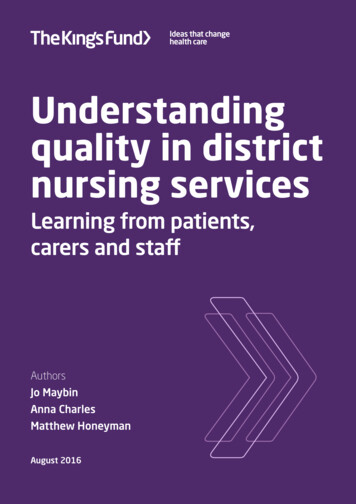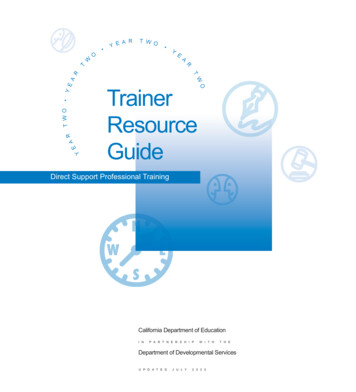
Transcription
Student Resource bookIntravenous & Related TherapyResource for StudentsMIDCENTRAL DISTRICT HEALTH BOARDINTRAVENOUS & RELATED THERAPIES – PRACTICE DEVELOPMENT UNIT2015Acknowledgements: Central Region District Health BoardsClinical Nurse Specialist (Lead) Intravenous & Related Therapies – Pager: 060. Ext. 8206Page 1
INTRODUCTIONThis resource is designed to assist students in gaining knowledge, confidence, and skills inperforming basic intravenous therapy. The content of this resource relates only to the BasicPrinciples of I.V. Therapy and DOES NOT INCLUDE; Insertion of peripheral I.V. catheters. Phlebotomy. Management of central venous access devices (CVAD). Management of patient controlled analgesia (PCA).IMPORTANT POINTS This resource is a supplement for student learning and skill development.Completion of this resource does not equate to being certified in Fundamental I.V. &Related Therapies.A student is not allowed to manage any I.V. therapy unsupervised.A student must work under the direction and delegation of a registered healthpractitioner when providing I.V. & related therapy care.This document is best utilized in conjunction with other resources. Resources can beyour nurse lecturer, clinical nurse educator, ward based I.V. Resource or Preceptor,Notes on Injectable Drugs, New Zealand Formulary.HOW TO FIND THE ONLINE DOCUMENTSClinical Nurse Specialist (Lead) Intravenous & Related Therapies – Pager: 060. Ext. 8206Page 2
SUPPLEMENTAL WEB SITEShttp://www.ins1.org/ - Recognized as the global authority in infusion therapy, INS is dedicatedto exceeding the public’s expectations of excellence by setting the standard for infusion care.http://www.ivteam.com/ - IVTEAM is an online resource for the practitioner working in thefield of IV therapy. IVTEAM provide free IV news and updates to the whole of the world via theWorld Wide Web.http://www.iv-therapy.net/ - Focus on vascular therapy. Includes Chat forums, Great photos ofIV related problems, Numerous IV related articleshttp://www.ivaccess.com/ - A quick and easy reference to find the pH and Osmolarity ofmedicines.DEFINITION OF TERMS(Source: Nursing Council New Zealand) DELEGATION - The transfer of the responsibility for the performance of a task/activityfrom one person to another, with the former person retaining accountability for theprocess and the outcome. DIRECTION - The active process of directing, guiding, monitoring and influencing theoutcome of an individual’s performance of a task/activity related to assigned aspects ofpatient care. DIRECT DIRECTION – Direction is provided directly when the registered healthprofessional is actually present, observes, works with and directs the person who isbeing supervised. Direct direction is required when assessing the skill or competencylevel of another. INDIRECT DIRECTION - Direction is provided indirectly when the registered healthprofessional in the same facility or organisation as the supervised person but does notconstantly observe his/her activities. The registered health professional must beavailable for reasonable access (i.e. on-site and accessible within a few minutes). DOUBLE CHECKING - Double checking must be performed in situations where it isappropriate or legally necessary; - e.g. when checking controlled drugs, blood products,dosage calculations, etc.Clinical Nurse Specialist (Lead) Intravenous & Related Therapies – Pager: 060. Ext. 8206Page 3
IV Medicines Administration Decision Making FrameworkWhat is concerning you aboutadministering this IVmedication?Identify the concern:Skill/knowledge: You lack the knowledge or skill to administer and/or monitor the patient Other nursing staff in the area lack the knowledge or skill to administerand/or monitor the patientThe medication: Rarely given in the clinical/practice setting High risk of side effects/potential for error (see list)Monitoring: Staffing skill mix inadequate/does not allow for close monitoring of thepatient High degree of monitoring/frequency of observations required e.g.telemetryThe Route: Route of administration increases risk e.g. central lineDrug Data:Ministry of Health/Medsafe datasheets (notexclusive): Concentrated potassium bolus Heparin Insulin Infusion Morphine or other Opioid Cytotoxics Intravenous infusionsResources:Senior nurses in area/Coordinator/ACN/CNM/EducatorAfter-hours management (AHM)Notes on Injectable DrugsPharmacistMake the decision:Discuss with senior nurse in charge:Analyse the individual situationUse clinical judgement to make a decision to administer or not basedon the risk vs benefitNoto the patientUse resources (see list) available to guide administration decisionInform prescriber of issues involvedCan you or another nurse in theclinical area safely administer themedicine?NoThe nurse caring for the patient takes responsibility for ensuring thepatient receives medication in a timely manner by making alternativearrangementsNB: inform medical staff of potential delay to administration.Options for administration include:1) Medical staff administers Remains in the ward/unit for appropriate timeframe afteradministration Ensure doctor to doctor handover Clearly documents a management plan in patientsnotes(monitoring requirements, when to notify Dr etc)Senior nurse in charge supports following:2) Appropriate trained and skilled senior nurse from another areaadministers or supervisors administration, e.g. AHM, CCON3) Patient is transferred to a more appropriate clinical area foradministration, e.g. ICU, CCUTransfusion medicine departmentIV Compendium & MAPC Manual/DocumentCentre/Pages/Home.aspx#New Zealand FormularyMedsafe http://www.medsafe.govt.nz/YesYesMedication Administered Ensure management plan inplace (monitoringrequirements, when to notifyDr etc) Document process & actionstaken Complete Riskman incidentform if required (e.g.significant delay inadministration)ResolvedNoSeek advice from Medical staff,,Senior Nurse inCharge/DNM/Pharmacist Document Complete incident/event formon Riskman Inform prescriber of issuesinvolvedClinical Nurse Specialist (Lead) Intravenous & Related Therapies – Pager: 060. Ext. 8206Page 4
DOSAGES & CALCULATIONSKnow Your Basic Drug Calculations 1 kilogram (kg)1 gram (g)1 milligram (mg)1 liter (L) 1000 grams (g)1000 milligrams (mg)1000 micrograms (mcg)1000 milliliters (ml)To convert grams into milligrams multiply the grams by 1000.To convert milligrams to micrograms multiply the milligrams by 1000.To convert micrograms into milligrams divide the micrograms by 1000.To convert milligrams to grams divide the milligrams by 1000.Example:Express 4200 grams in kilograms Answer: 4200 g 1000 4.2 kgExpress 1.5 grams in milligrams Answer: 1.5 g x 1000 1500 milligramsExpress 3000 milligrams in grams Answer: 3000 mg 1000 3 gramsDrug Dosage Formula(What you want What you have) x Volume in ml.Example:Prescribed dose 20 mg.Stock dose 80 mg / 10 mlAnswer: (20 mg 80 mg) x 10 ml Give 2.5 mlUsing Body Weightmg/kg - mg x patient mass in kgmcg/kg - mcg x patient mass in kgExample:The dose for drug “A” is 10 mg / kg / every 8 hours. The patient weighs 48 kg. Howmilligrams of the drug should the patient receive every 8 hours?Answer: 10 mg x 48 kg Give 480 milligrams every 8 hoursClinical Nurse Specialist (Lead) Intravenous & Related Therapies – Pager: 060. Ext. 8206Page 5
Percentages %Percentages as expressed in intravenous solutions refer to the number of grams dissolved in100 ml of solution.ExampleGlucose 5% means there is 5 grams of glucose / 100 mLGlucose 10% means there is 10 grams of glucose / 100 mLGlucose 50% means there is 50 grams of glucose / 100 mLFluid Rate Formula (ml/hr)Volume to be infused Hours to be infusedExampleAdminister 1000 ml of 0.9% Sodium Chloride over 8 hoursAnswer: 1000 ml 8 hours Rate of infusion is 125 ml/hrFluid Rate formula (drops/ min)Volume to be infused (ml) x Drop FactorTime (min.)ExampleAdminister 1000 ml of 0.9% Sodium Chloride over 8 hours. The drop factor of the IVadministration set is 20 drops/ml.Answer: (1000 ml x 20) 480 minutes 41.6 drops /minute (round-off to 42)What is a “DROP FACTOR”? A “drop factor” is the number of drops needed to make up 1ml.The drop factor may vary depending on the infusion line being used. The drop factor is alwaysprinted on the packaging.What’s the use of calculating DROP RATES when we have electronic pumps? Drop ratecalculation is a basic calculation skill in IV therapy. You may need to calculate drop rates whenan electronic infusion device is unavailable.Clinical Nurse Specialist (Lead) Intravenous & Related Therapies – Pager: 060. Ext. 8206Page 6
Body Surface Area / BSA (m²): Mosteller formula.Get the square root ( ) of:Height (cm) x Weight (kg) 3600ExamplePatient “A” is 170 cm tall and weighs 85 kg. What is the patient’s BSA?Answer: (170 cm x 85 kg) 3600 4.013Press the square root function for 4.013, the BSA is 2.003Peripheral IV Cannula secured with transparent dressing and tapeClinical Nurse Specialist (Lead) Intravenous & Related Therapies – Pager: 060. Ext. 8206Page 7
FUNDAMENTAL INTRAVENOUS KNOWLEDGEI.V. CANNULA SITESClinical Nurse Specialist (Lead) Intravenous & Related Therapies – Pager: 060. Ext. 8206Page 8
I.V. CANNULA GAUGES AND MAXIMUM FLOW RATESGAUGECOLOURMAX. FLOW RATEUSE14gRed19,800 ml/hrFluid resuscitationSurgery16gGrey13,200 ml/hrFluid resuscitationSurgery18gGreen6,300ml/hrIV infusions inc. bloodBolus medication20gPink3,800ml/hrIV infusionsMinimum size for bloodproduct transfusion22gLight blue2,160ml/hrIV fluid infusionsFrail, elderly & young24gYellow1,440ml/hrIV fluid infusionsNeonates, children, & frailREMEMBER:G-20 (pink) is the smallest gauge recommended for adult blood transfusion.G-22 (blue) is the smallest gauge recommended for pediatric blood transfusion.G-24 (yellow) is the smallest gauge recommended for neonatal blood transfusion.PHLEBITISIt is important for all nurses caring for patients to understand and recognize phlebitis. Earlyidentification of phlebitis is necessary to ensure prompt treatment and prevent thedevelopment of other complications such as blood stream infections. Extensive infection has anegative effect on both patient and the cost of health care.Clinical Nurse Specialist (Lead) Intravenous & Related Therapies – Pager: 060. Ext. 8206Page 9
THE PHLEBITIS SCALEREMEMBER: The dwell time for an I.V. cannula to remain in situ in adults is 72-96 hours. After96 hours, it is recommended that the I.V. cannula be removed. In the pediatric setting I.V.cannulas remain in situ as long as there is no complication.*For I.V. cannulas to remain in situ for longer than 96 hours, a clinical decision and rationalemust be provided and recorded in the clinical notes.If you observe phlebitis on your patient’s I.V. site, you should document the following in thepatient’s notes: Date, work shift, and time.Location of the phlebitis (e.g. Right antecubital fossa).Description of the phlebitis (e.g. red, inflamed, pus / discharge etc).Actions done (e.g. swabbed for culture, medical team and RN informed).Any relevant history (e.g. multiple venepuncture attempts on the same spot).Clinical Nurse Specialist (Lead) Intravenous & Related Therapies – Pager: 060. Ext. 8206Page 10
MANAGEMENT AND CARE of A PERIPHERAL I.V. CANNULAThe S-A-S ProtocolWhen accessing a peripheral I.V. cannula to give fluid or a medication, always follow the S-A-Sprotocol. S - Sodium chloride 0.9% flush (3 – 5 ml is sufficient). *To test the I.V.C. patency.A - Access / Administer the drug or fluid.S - Sodium chloride 0.9% flush (3 – 5 ml is sufficient). *To flush the medication andmaintain patency.REMEMBER:When flushing an I.V. cannula, ALWAYS lock it using the positive pressure technique. This isdone by simultaneously engaging the clamp on the I.V. cannula while flushing the last fewmilliliters of Sodium chloride 0.9%. This “locking under positive pressure” will prevent bloodfrom drawing back into the I.V. cannula thus, reducing the chances of occlusion.The Blocked IV CannulaWhen you experience partial resistance while flushing an I.V. cannula, it is acceptable to try tounblock it by applying gentle pressure while flushing. If full resistance is felt, even afterapplication of gentle pressure, it is advisable to remove and re-site the IV cannula. Forcefulflushing of an occluded I.V. cannula is not recommended as the force may dislodge a bloodclot, cause pain, or damage the vein.The Leaking I.V. CannulaA leaking I.V. cannula is best observed during flushing or during an infusion. The tell-tale signsare; wet linen, wet clothing, moist IV dressing, and a wet I.V. site. If you observe this, assess theI.V. site for the source of the leak.If the leak comes from the insertion site, it is recommended that the I.V. cannula be removed.The I.V. cannula may have been pulled out, bent, or damaged.Clinical Nurse Specialist (Lead) Intravenous & Related Therapies – Pager: 060. Ext. 8206Page 11
If the leak is coming from the connection (where the I.V. cannula is connected to the extensionset or access valve), simply secure the connection by ensuring the luer-lock connection is tight.If no leak is observed, you may re-secure the I.V. cannula by putting on a new dressing.Removing an I.V. CannulaRemoving an I.V. Cannula is simple and easy. It is also relatively painless if done using a propertechnique.What you need for removing an I.V. Cannula: 1 x small sterile gauze or pressure pad dressing.Tape roll.REMOVE wipes (adhesive remover).Alcohol or Clorhexidine swabs (*if needed for cleaning).Clean pair of gloves.Procedure1. Make sure that the cannula is no longer clinically indicated.2. Explain the procedure to the patient.3. Cleanse hands.4. Wear non-sterile gloves.5. Carefully remove the dressing and tape from the skin to expose the skin and cannula.6. Avoid manipulation of the device to prevent contamination and pain.7. Cover site with gauze square then gently remove the cannula.8. Apply digital pressure until bleeding has stopped. Secure the dressing in place.9. Dispose of surplus equipment.10. Cleanse hands.11. Document removal in clinical notes and record tissue integrity.12. Monitor ongoing healing and advise patient to report any symptoms of discomfort,bleeding, pain, swelling or redness.13. Alert the medical staff if the area is reddened14. If infection is suspected complete an incident report on Riskman.15. Advise patient to keep dressing on for at least 8 hours unless it is a pressure dressing,which must be removed within one hour of application (otherwise persistent pressuremay result in damage to the vein).16. On discharge, inform patient to notify GP if ongoing discomfort, swelling, heat ordischarge from site.Clinical Nurse Specialist (Lead) Intravenous & Related Therapies – Pager: 060. Ext. 8206Page 12
ADVERSE EFFECTS OF TRANSFUSION(Source: New Zealand Blood Service, 2008)Transfusions can both benefit and harm the patient. Good clinical practice depends onunderstanding the benefits and risks that each treatment can provide for patients, such as notusing a blood product or of using an alternative.Blood transfusion has become steadily safer over the years as various viruses and infectioushazards have been identified through donor selection procedures and blood screening tests.Though much effort is put into ensuring the safety of transfusion particularly in preventing viraltransmission, mistransfusion and non-infectious hazards of transfusion still account for asignificant proportion of the reported transfusion-related adverse events. Data on theoccurrence of adverse reactions and incidents are collected as part of NZBS’ haemovigilanceactivities.REPORTING ADVERSE REACTIONS OR INCIDENTSSerious or acute life-threatening reactions are rare so any new or unexpected symptomsduring transfusion must be taken seriously as they may be an early warning of a seriousreaction. Severe reactions are most likely to occur within 15 minutes of starting transfusion ofeach individual unit of blood products. It is extremely important to closely monitor the patient during this initial 15 minuteperiod and then at regular intervals. Serious events must be discussed with a NZBS Transfusion Medicine Specialist orclinical haematologist for advice on further management of the patient, laboratoryinvestigations and future transfusion requirements.Clinical Nurse Specialist (Lead) Intravenous & Related Therapies – Pager: 060. Ext. 8206Page 13
Signs and Symptoms of Anaphylactoid/Anaphylactic Reactions (Transfusion MedicineHandbook, NZBS, 2008)SymptomsDyspnoeaChest painAbdominal painNauseaSignsHypotensionBronchospasmPeriorbital and laryngeal oedemaVomitingErythemaUrticariaConjunctivitisSigns and Symptoms of Acute Haemolytic Reaction (Transfusion Medicine Handbook, NZBS,2008)SymptomsFeeling of apprehension or “sense ofimpending doom”AgitationPain at the venepuncture sitePain in the abdomen, flank or chestDifficulty breathingSignsUnexplained feverFlushingHypotension, or sudden onset ofhypertensionGeneral oozing from wounds orpuncture sitesHaemoglobinaemiaHaemoglobinuriaSkin rashBacterial Contamination: Signs and symptoms of septic reaction includes: (TransfusionMedicine Handbook, NZBS, 2008):Fever (temperature 38.5 C or a rise from baseline of 1.5 rdia ( 120 beats per minute or change from baseline of 40 beats per minute)Hypotension or hypertension (rise / fall in systolic blood pressure of 30 mm Hg)HaemolysisShockMultiple organ failure during or immediately after the transfusionClinical Nurse Specialist (Lead) Intravenous & Related Therapies – Pager: 060. Ext. 8206Page 14
INTRAVENOUS EQUIPMENTAlcohol swabs are used to thoroughlycleanse the injection ports and accessvalves prior to each access. Whencleansing the access ports scrub for 15seconds and wait for 15 seconds to dry.Prefilled sodium chloride 0.9% syringes arequick and easy to use. While the cap is stillsecure, push on the plunger to release thestopper seal (a small ‘click’ will be felt).Once the seal has been disengaged thesyringe is ready to flush.Blunt fill needles are used to draw updiluents from ampoules e.g. Water forInjection or Sodium Chloride 0.9% or whenmixing medications using vials with rubberstoppers. You can also use the BLUNT FILLNEEDLE to inject additives into IV bags.Blunt filter needles are used to draw upmedications from glass ampoules becauseof the potential presence of glassfragments or sediments.Clinical Nurse Specialist (Lead) Intravenous & Related Therapies – Pager: 060. Ext. 8206Page 15
Infusion sets are used to give IV medicines.They can be used with or without anelectronic IV pump. These infusion sets canbe used for 72 – 96 hours. When givingmedications or blood products, follow yourclinical area’s protocol for hang times.Mechanical valves and split septum injectioncaps are needle-less access devices. Theycan be found on the patient’s IV extensionset or as a side port on an infusion set.Before you access these, make sure that youscrub the hub for 15 seconds using analcohol swab and wait to air dry. Secureyour syringe onto the access valve by luerlocking.The Alaris System infusion pump is used fordelivering IV fluids, blood products, andmedications. It is recommended to keep thepump plugged-in at all times to keep thebattery charged. Faulty pumps must have aBeims form completed and sent to theBiomedical Engineering department forrepair.The Alaris syringe driver is used fordelivering IV infusions and medications.There are two models CC (critical care) andGH (general hospital)Clinical Nurse Specialist (Lead) Intravenous & Related Therapies – Pager: 060. Ext. 8206Page 16
The NIKI T 34 is a portable syringe driverprimarily used to deliver subcutaneousinfusions.Glass ampoules contain medications andsolutions. The easiest way to break anampule is to hold it securely and break itwith the dot pointing ‘away from you’.Holding onto the ampoule too tightly mayresult to a complete breakage of the wholeampoule.Medication vials may contain medicationsand solutions in either powder or fluidform. Vials are sealed with plastic tops andhave rubber stoppers. Make sure that youcleanse the rubber tops with alcohol swabsbefore accessing with a blunt needle.Reduce the risk of needle stick injury bydisposing your sharp equipment (needles,spikes, air inlet needles, broken ampolesetc.), in the sharps bin.We encourage clinicians to dispose ofsharps “at the point of contact” and not tocarry sharps around in unsafe containers.As part of your training it is important that you know the various intravenous equipment, theiruses, and the correct disposal. Your role in equipment selection is to ensure the safe andeffective delivery of IV therapy health care to the patient.Clinical Nurse Specialist (Lead) Intravenous & Related Therapies – Pager: 060. Ext. 8206Page 17
FLUID BALANCE CHART MANAGEMENTThe purpose of fluid balance charts (FBC) is to ensure fluid intake and output are accuratelymonitored.The hydration status of patient’s receiving intravenous therapy is assessed each day.(a) All intravenous fluids infused via an Electronic Infusing Device (EID) should be visuallychecked every 30 – 60 minutes to see if the infusion is being delivered correctly.(b) Free flowing fluids (i.e. gravity - not infused via an EID) are checked every 15 – 30minutes because fluids will sometimes infuse “too fast” or “too slow” depending on theI.V. cannula placement, patient movement, height of the infusion, etc.(c) Consider recording fluid intake and output every hour onto fluid balance chart if thereare additives in the fluid, if being delivered with a burette or EID, or if the patient’scondition calls for it (e.g. renal failure, congestive heart failure).(d) When a patient is on an EID cross check volume infused against fluid balance chart priorto clearing total.(e) Fluid balance charts are to be totaled at the end of each shift.(f) The 24 hour total is then entered onto a fluid balance summary.(g) All columns are to be totaled prior to transfer from one unit to another.REMEMBER:Fluid balance charts are required to record fluid input and output of all patients receivingintravenous therapy.A fluid balance summary chart must be used to record the daily totals from the fluid balancechart and hydration charts.The fluid balance chart must be retained as part of the patient’s record.Clinical Nurse Specialist (Lead) Intravenous & Related Therapies – Pager: 060. Ext. 8206Page 18
PRACTICAL SKILL ACTIVITIESIn order to enhance I.V. knowledge and skills you will need to apply what you have learnt.Hence, you will need to carry-out some “hands on” basic I.V. therapy under the direct directionof a registered nurse who holds a MidCentral Health Fundamental Intravenous Certification.Do not, in any circumstance, perform any of these I.V. tasks without the direct direction of aregistered nurse.Learn to do these activities under the direct direction of a registered nurse:1. Prepare and reconstitute an IV medication.2. Administer a sodium chloride 0.9% flush or an antibiotic through a peripheral IVcannula.3. Prime IV infusions set, and administer an IV fluid using an electronic infusion device.4. Observe how to set-up a blood product transfusion and observe how it is commenced.5. Removal of a peripheral IV cannula.REMEMBER:The 5 Rights of medication administration.The indication, action, side effects and adverse effects of medications / IV fluids.Patient communication and gaining consent.Patient assessment (before, during, and after).Use of the right equipment.Observe infection prevention & control.DocumentationREFERENCES:thAlexander, M. Corrigan, A. (2011) Core curriculum for infusion nursing. (4 ED, Norwood, Lippincott, Williams &Wilkins.ndDougherty, L. & Lamb, J. (2008). Intravenous therapy in nursing practice. (2 ED, Wiley-Blackwell.Higginson, R., & Parry, A. (2011). Phlebitis: treatment, care & prevention. Nursing Times, 107 (36), 18-21.Jackson, A. (1998). A battle in vein: infusion phlebitis. Nursing Times, January 28,94, (4), 70 – 71New Zealand Blood Service (2008). Transfusion Medicine Handbook.thWeinstein, S. M. (2007). Plumer’s principles & Practice of Intravenous Therapy. (8 ED), Philadelphia: Lippincott,Williams & Wilkins.Clinical Nurse Specialist (Lead) Intravenous & Related Therapies – Pager: 060. Ext. 8206Page 19
Drug Dosage Formula (What you want What you have) x Volume in ml. Example: Prescribed dose 20 mg. Stock dose 80 mg / 10 ml Answer: (20 mg 80 mg) x 10 ml Give 2.5 ml Using Body Weight mg/kg - mg x patient mass in kg mcg/kg - mcg x patient mass in kg Example: The dose for drug A is 10 mg / kg / every 8 hours. The patient weighs 48 kg.










